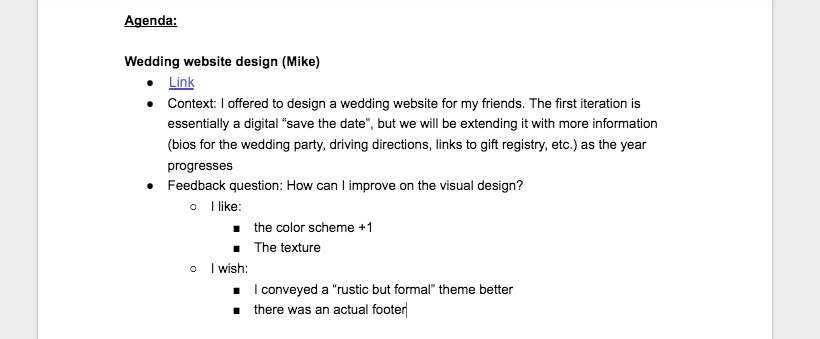Feedback Session define
Tools
- Video conferencing app
- Screensharing app
- Collaborative text editor
Why do it:
Working as a lone wolf designer can be dangerous because you are relying on your own assumptions, background and expertise to make decisions. A feedback session shares the risk and responsibility.
When to do it:
It’s a tricky thing to decide when to run a feedback session. In general, when working on a project, you should routinely be running feedback sessions.
Who’s involved:
Try to get as many stakeholders and product team members as you can in the room. Having a feedback session for just the “design team” can be effective for technique based decisions, but the goal is to gather a set of diverse voices to inform your work. Engineers can be effective feedback participants because it gives them a chance to think about the problem space well before implementation begins.
One way to do it:
-
Schedule and announce your feedback session in advance. A feedback or critique meeting can be mentally taxing for all participants, so plan for it to take no longer than 90 minutes if anyone is not co-located. The guest list is the core team working on the project. All participants are permitted to invite guests. The session will happen in a place that allows for screen sharing and video chatting (Appear.in or Google Hangouts) as well as within a text editor (Google Docs or Etherpad). Having multiple data points for collecting feedback will help all participants. Visual cues help participants to read body language and while written feedback can documents next steps or any decisions made.
-
Break down the schedule based on the total time that you have set aside for the session. Each presenter should prepare materials to share prior to the session. Presenters should come with a question to the call. The most constructive feedback is in response to a specific inquiry, rather than a vague “so what do you think?”
-
Inform all attendees how they can participate. At a feedback session, everyone needs to take on a role. Here are the different types of roles:
- Presenter: shares work
- Timer: keeps everyone on track
- Feedback Provider: gives constructive feedback and criticism
If participants invite a guest, inform the guest as to why they are being invited to the call and explain to them what role they are expected to play in the meeting. For example, “Hey Shaq, I’m so glad that you can make it to the feedback session on Wednesday. Considering your expertise in basketball, I would love for you to give feedback about the services targeted at the sports industry when I share the mockups for the Services page.”
-
Guide and document feedback by asking participants to treat this call as a safe space and to share respect for ideas. This is the place for questioning and creativity. Provide the group with a Google Doc or Etherpad for an agenda with times and asynchronous note taking. Everyone on the call shares the responsibility of notetaking.
-
Don’t be shy about being critical. It is easy to be blown away by beautiful design or code, but in order for us to evolve our work, we need to hear what’s not working. Have participants think about formulating their feedback as filling in the blank of one of the following statements (these prompts should be written into the agenda):
- I like _______ .
- I wish ______ .

-
Define next steps in writing for every project. This will help presenters to take action after the call and will help you as the feedback session facilitator to set up the next feedback session because you will have a prepared agenda.